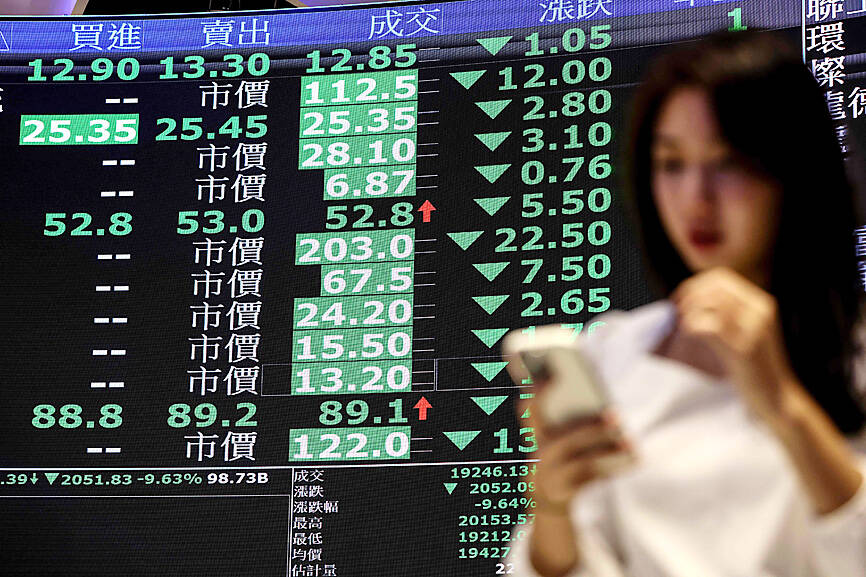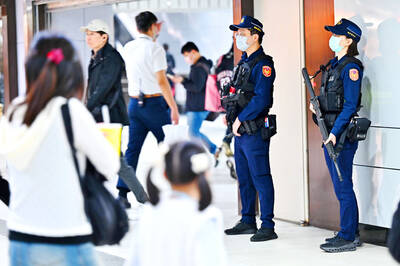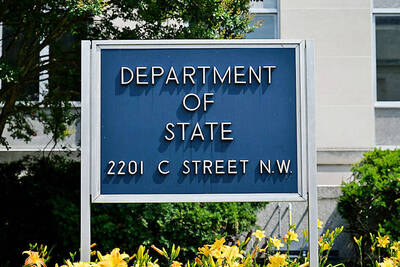The TAIEX plunged 2,065.87 points, or 9.7 percent, to close at 19,232.35 yesterday, the highest single-day percentage loss on record, as investors braced for US President Donald Trump’s tariffs after an extended holiday weekend.
Amid the pessimistic atmosphere, 945 listed companies led by large-cap stocks — including Taiwan Semiconductor Manufacturing Co (TSMC, 台積電), Hon Hai Precision Industry Co (鴻海精密) and Largan Precision Co (大立光) — fell by the daily maximum of 10 percent at the close, Taiwan Stock Exchange data showed.
The number of listed companies ending limit-down set a new record, the exchange said.

Photo: Cheng I-hwa, AFP
The TAIEX plunged by daily maxiumu in just 10 minutes after the market opened, even though the Financial Supervisory Commission announced temporary measures on Sunday that aim to curb short selling and keep local shares stabilized.
“The Taiwan index is tech-dominant and their tech companies are closely tied to US clients, thus suffering from dual concerns related to the US over AI [artificial intelligence] investments, and both first and second order impact of tariffs,” Aberdeen Investments fund manager Ng Xin-yao (黃新耀) told Bloomberg News.
Despite the sell-off, turnover on the local market totaled only NT$147.295 billion (US$4.46 billion), the lowest single-day total in more than two years, while foreign institutional investors bought a net NT$16.82 billion of shares yesterday, exchange data showed.
“The low turnover showed many investors were reluctant to buy the dip as they expect more losses to follow due to the tariff shocks,” Mega International Investment Services Corp (兆豐國際投顧) analyst Alex Huang (黃國偉) said.
The local stock market was closed for a holiday on Thursday and Friday last week as trillions of US dollars were wiped off the value of global stocks and nations scrambled to limit the impact of Trump’s reciprocal tariffs announced on Wednesday last week, which imposed an unexpectedly high 32 percent tariff on Taiwan.
Taiwan Stock Exchange chairman Sherman Lin (林修銘) said before the market opened that the local bourse would inevitably fluctuate because of the shocks from global markets.
“The exchange will pay attention to the changes in the international situation and cooperate closely with local companies,” Lin said. “The government will support local industries with full force and start conversations with the US government to seek the possibility of lowering the tariffs.”
Lin also encouraged listed companies to make financial information transparent, keep investors posted on their responses to Trump’s reciprocal tariffs and implement share buyback schemes to stabilize prices and bolster investor confidence.
Meanwhile, the steering committee of the National Stabilization Fund is expected to hold a meeting as soon as today to discuss how and when to utilize the NT$500 billion fund to help buffer the market sell-off, the Ministry of Finance said.
Beyond Taiwan, Asian and European equities collapsed on a black Monday for markets after China hammered the US with its own hefty tariffs, ramping up a trade war that many fear could spark a recession.
Hong Kong lost 13.22 percent, its worst performance in nearly three decades, and Shanghai shed more than 7 percent. Tokyo and Singapore fell almost 8 percent, while Seoul gave up more than 5 percent, triggering a so-called sidecar mechanism — for the first time in eight months — that briefly halted some trading.
Sydney, Wellington, Manila and Mumbai were also deep in the red, Frankfurt dived 10 percent, while London and Paris both dropped about 5 percent.
Additional reporting by AFP and CNA

A car bomb killed a senior Russian general in southern Moscow yesterday morning, the latest high-profile army figure to be blown up in a blast that came just hours after Russian and Ukrainian delegates held separate talks in Miami on a plan to end the war. Kyiv has not commented on the incident, but Russian investigators said they were probing whether the blast was “linked” to “Ukrainian special forces.” The attack was similar to other assassinations of generals and pro-war figures that have either been claimed, or are widely believed to have been orchestrated, by Ukraine. Russian Lieutenant General Fanil Sarvarov, 56, head

SAFETY FIRST: Double the number of police were deployed at the Taipei Marathon, while other cities released plans to bolster public event safety Authorities across Taiwan have stepped up security measures ahead of Christmas and New Year events, following a knife and smoke bomb attack in Taipei on Friday that left four people dead and 11 injured. In a bid to prevent potential copycat incidents, police deployments have been expanded for large gatherings, transport hubs, and other crowded public spaces, according to official statements from police and city authorities. Taipei Mayor Chiang Wan-an (蔣萬安) said the city has “comprehensively raised security readiness” in crowded areas, increased police deployments with armed officers, and intensified patrols during weekends and nighttime hours. For large-scale events, security checkpoints and explosives

PUBLIC SAFETY: The premier said that security would be tightened in transport hubs, while President Lai commended the public for their bravery The government is to deploy more police, including rapid response units, in crowded public areas to ensure a swift response to any threats, President William Lai (賴清德) said yesterday after a knife attack killed three people and injured 11 in Taipei the previous day. Lai made the remarks following a briefing by the National Police Agency on the progress of the investigation, saying that the attack underscored the importance of cooperation in public security between the central and local governments. The attack unfolded in the early evening on Friday around Taipei Main Station’s M7 exit and later near the Taipei MRT’s Zhongshan

REBUFFED: In response to Chinese criticism over recent arms sales, Washington urged Beijing to engage in meaningful dialogue instead of threats and intimidation Washington’s long-term commitment to Taiwan would not change, the US Department of State said yesterday, urging Beijing to stop pressuring Taiwan and engage in meaningful bilateral dialogues. The remarks came in response to a backlash from Beijing about Washington’s latest approval of arms sales to Taiwan. The US Defense Security Cooperation Agency said in a statement on Wednesday that the Taipei Economic and Cultural Representative Office in the US has asked to purchase an arms package, including Tactical Mission Network Software; AH-1W helicopter spare and repair parts; M109A7 self-propelled howitzers; HIMARS long range precision strike systems; tube-launched, optically tracked, wire-guided missiles; Javelin